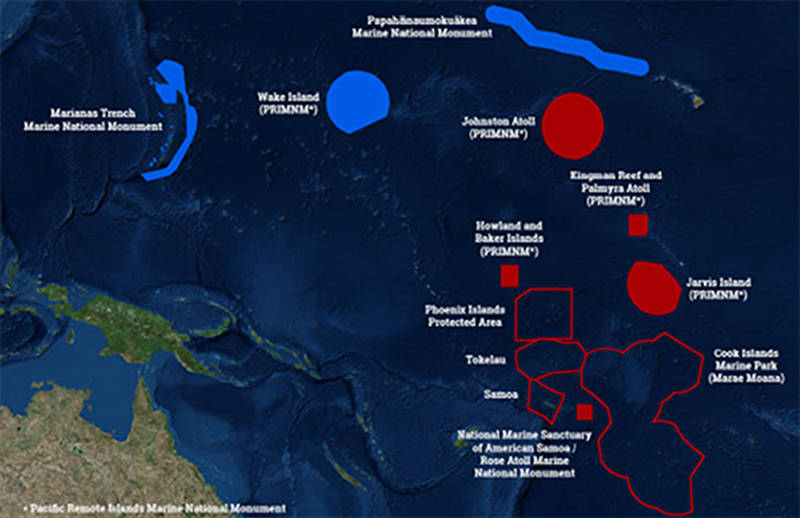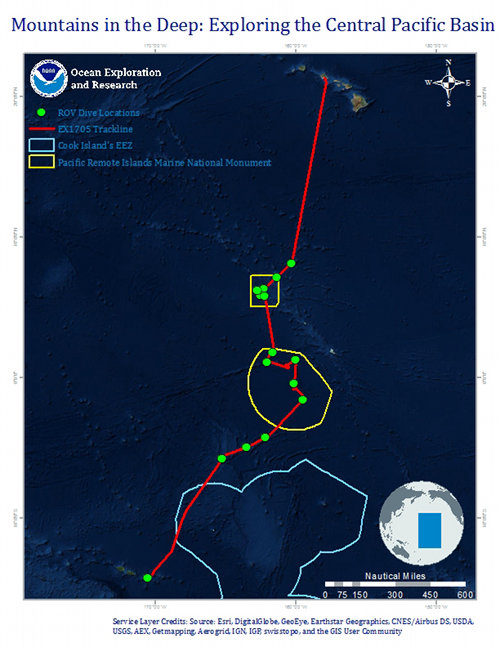

This map shows the U.S. Marine National Monuments in the Pacific Ocean (solid blue and solid red polygons) – the focus of operations for 2015-2017. The 2017 expeditions will take place in the central Pacific, focusing efforts in the vicinity of the Hawaiian archipelago; the Kingman/Palmyra, Jarvis, and Howland/Baker units of the Pacific Remote Islands Marine National Monument (PRIMNM), now known as Pacific Islands Heritage Marine National Monument; National Marine Sanctuary of American Samoa; and Rose Atoll Marine National Monument. Image courtesy of the NOAA Office of Ocean Exploration and Research. Download image (jpg, 57 KB).
In January 2017, NOAA Ship Okeanos Explorer began her first expedition of what remains in a three-year effort to investigate the rich biodiversity and dynamic geology in deepwater environments of the U.S. central and western Pacific Ocean. This three-year exploration campaign, titled the Campaign to Address Pacific monument Science, Technology, and Ocean NEeds (CAPSTONE) involves the systematic collection of baseline information to support science and management needs within and around marine monuments and other protected places in the Pacific. It also serves as an opportunity for NOAA and the nation to highlight the uniqueness and importance of these national symbols of ocean conservation.

Map of the general expedition operating area. The red line is the rough cruise track from American Samoa to Honolulu during the expedition. The yellow polygons represent the boundaries of the Pacific Remote Islands Marine National Monument, now known as Pacific Islands Heritage Marine National Monument. The light blue polygon designates Marae Moana (Cook Islands). Planned ROV dives are represented by green markers. Image courtesy of the NOAA Office of Ocean Exploration and Research. Download image (jpg, 54 KB).
In late February, scientists explored Rose Atoll Marine National Monument, National Marine Sanctuary of American Samoa, offshore (not within) of the National Park of American Samoa, and the waters of both American Samoa and Samoa. Information on that expedition can be found here.
In March, the science team explored areas off the Swains Atoll in American Samoa before following the Tokelau seamount trail north through Tokelau and PIPA into the Howland/Baker Islands unit of the PRIMNM. Information on that expedition can be found here.
From April 27 through May 19, 2017, the Mountains in the Deep: Exploring the Central Pacific Basin expedition will include investigation of deepwater areas in the Kingman Reef and Palmyra Atoll and Jarvis Island Units of the Pacific Remote Islands Marine National Monument (PRIMNM), now known as Pacific Islands Heritage Marine National Monument, around the Cook Islands Marine Park, and the high seas.
Largely unexplored, the PRIMNM is the largest marine protected area in the world [370,000 square nautical miles (1,269,065 square kilometers)] and is inhabited by the most widespread collection of marine life under a single country's jurisdiction. This expedition will traverse seamounts and atolls at depths between 250-6,000 meters, as we work to better understand the deep-sea habitats of the Central Pacific Basin.
During this expedition, the exploration strategy of NOAA Ship Okeanos Explorer will be employed: bathymetric mapping using multibeam sonar; water column exploration using a Conductivity, Temperature and Depth Profiler (CTD); and remote imaging and video with Deep Discoverer.
Scientists from around the world will be participating in the explorations in real time through telepresence technology and students and the general public can watch and listen to remotely operated vehicle dives in real time on the NOAA Ocean Explorer website.